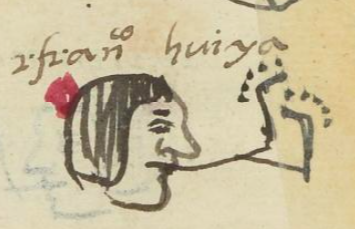Huiya (MH567r)
This black-line drawing of the simplex glyph for the personal name Huiya (“He went” or "He Left," attested here as a man’s name) shows two alternating footprints heading upward, suggesting movement. The past tense of the verb is not shown visually.
Stephanie Wood
Footprint glyphs have a wide range of translations. In this collection, so far, we can attest to yauh, xo, pano, -pan, paina, temo, nemi, quetza, otli, iyaquic hualiloti, huallauh, tetepotztoca, totoco, -tihui, and the vowel "o." Other research (Herrera et al, 2005, 64) points to additional terms, including: choloa, tlaloa, totoyoa, eco, aci, quiza, maxalihui, centlacxitl, and xocpalli.
1560
footprints, huellas, icximachiyotl, xocpalli, icxipamitl, irse, salir, to leave, nombres de hombres

huiya, went, from verb, https://nahuatl.wired-humanities.org/content/huiya
yauh, to go, https://nahuatl.wired-humanities.org/content/yauh
Se Fue
Stephanie Wood
Matrícula de Huexotzinco, folio 567r, World Digital Library, https://www.loc.gov/resource/gdcwdl.wdl_15282/?sp=213&st=image.
This manuscript is hosted by the Library of Congress and the World Digital Library; used here with the Creative Commons, “Attribution-NonCommercial-ShareAlike 3.0 License” (CC-BY-NC-SAq 3.0).


